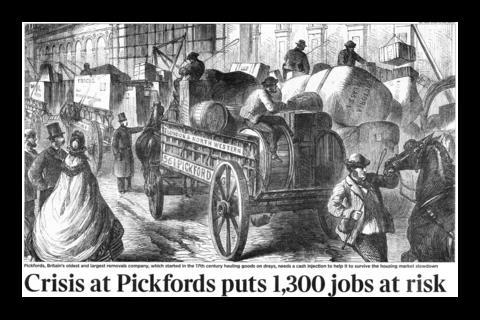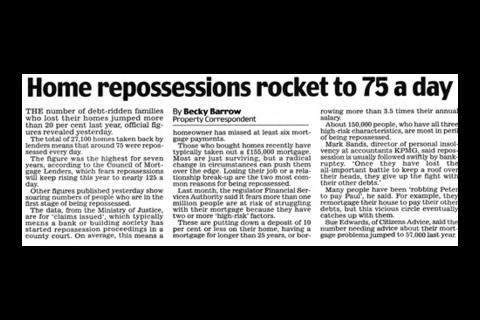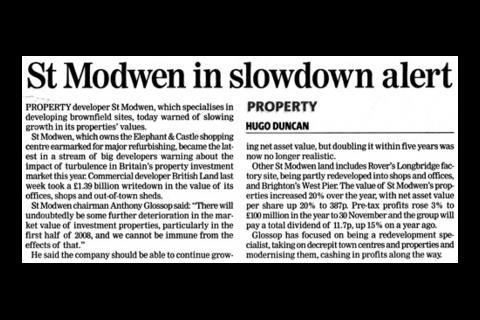The days of a booming economy and generous public expenditure are over – just when the core cities were beginning to count their successes. So can urban regeneration projects still prosper in today’s harsher climate? David Blackman finds out
The economic headlines make bleak reading for anybody involved in development. The urban living boom, which has transformed the face of city centres across the North and the Midlands, has gone distinctly flat in the past six months.
But even before the credit crunch, many were sceptical that building micro-flats for footloose investors represented a sustainable regeneration strategy. Last year Regenerate reported on buy-to-let schemes bedevilled by poor management in Thamesmead in the Thames Gateway, a story picked up by the BBC’s Panorama this month. Other apartments in city schemes have been kept empty by their owners.
But a look at the retail and office sectors, the other big drivers of development, does not offer much relief. In the core cities, the impact of the current downturn is likely to be compounded by the slowdown in public expenditure.
The Northern and Midlands regions will be particularly affected because their economies rely more on the public sector. Professor Michael Parkinson, author of the government’s State of the Cities report, says: “We know that the next 10 years will be very different from the last 10.
In the last 10 years a lot of big cities have come back a long way. However, that has been done by having a booming public economy and high levels of public expenditure.”
There have been many regeneration success stories across the core cities, so much so that outsiders might even regard the recent regeneration boom as having done its job. In reality, there is a lot more to be done. Neil McInroy, director of the Centre for Local Economic Strategies, points out that nearly a quarter of a million working-age people are still jobless in Birmingham and Greater Manchester. “We have had two different economies working in our cities in a period of largesse, both in terms of public spending and economic growth. We need to think a lot smarter about how we do it.”
Regenerate has spoken to experts to find out how the core cities’ fledgling recovery can cope in the harsh new climate. Over the next three pages, we look at the various scenarios for city development and where best to look for some good news.
And does the looming downturn in fact offer opportunities for a more sustainable form of regeneration?
Retail
It’s one of the big drivers of recent city-centre regeneration, but the retail sector offers little cause for optimism.
Recent trading statements from the big high-street names have not made comfortable reading. The uncertainty in the retail market could hardly have come at a worse time, with an unprecedented wave of shopping centre openings due to take place over the next 12 months.
Agent King Sturge estimates that 14 major shopping centres will open across the country this year, offering 8.5 million ft2 of floorspace. The biggest of these schemes is Grosvenor’s Liverpool One development, which is due to welcome its first shoppers in May, closely followed by Bristol’s 1.5 million ft2 Cabot Circus.
Such a large amount of development is bound to give those considering new retail-led schemes pause for thought, especially when the internet’s growing share of shopping expenditure is taken into account. “There’s a lot of space and people don’t have so much money in their pockets,” says Nigel Cooper, director of retail planning at agent Colliers CRE.
But Chris Goddard, director of retail planning at GVA Grimley, takes a more upbeat view. “Retailers are not slowing their long-term expansionary programmes. Most proactive retailers recognise that they can’t stand still and that there’s an opportunity to increase their market share. If the market is challenging, concepts change and retailers develop new formats and focus on stronger centres.”
This optimistic scenario may not provide salvation for the large wave of smaller centres pinning their hopes on capturing a slice of the retail regeneration pie. Bill Boler, director of the underserved retail markets project at Business in the Community, believes developers would be wise to spread their risk by developing mixed-use projects. “The projects that are solely retail-led or housing-led are going to be hit,” he says. He believes it will be a long time before there is a repeat of the current wave of new shopping centres.
“Local authorities are going to have to work a lot harder to get the partners they want. The days of putting up a sign and waiting for the developers to come have gone.”
Good news potential: Medium if risk is spread
Residential
Even before the credit crunch, developers were getting twitchy about the sustainability of the buy-to-let sector, according to Yolande Barnes, head of mixed-use research at property agent Savills. In Nottingham city centre, for example, the average price of a flat has declined since 2001, because of a combination of over-supply and the shrinking average size of units.
As a result, some detect a silver lining in current market gloom. “It has been too easy; developers have had it their own way,” says Duncan Sutherland, chief executive of regeneration developer Inpartnership.
Sutherland believes a less commercially pressured environment, in which land is at less of a premium, offers scope for what he describes as true regeneration.
“You have the chance to include the things that make a community work rather than putting a load of stuff up,” he says. “We have to get away from the preoccupation with buy-to-let, which is causing the problems.”
Warren Smith, chairman of Salford Quays-based LPC Living, says there is still healthy demand for flats in the company’s refurbished council tower blocks. “The first-time buyer is a worthwhile market to be in,” he says, pointing out that there is still very little housing available for people earning average wages.
Sutherland agrees that regeneration projects continue to offer healthy returns, even in a quiet market. In north Solihull, where Inpartnership is involved in the redevelopment of one of the UK’s biggest council estates, values are one third lower than in the surrounding area, which provides plenty of margin to work with, he says.
Sutherland suggests developers will have to become more imaginative – for example, by getting more involved in shared-equity schemes. “You have to work it a bit harder, but regeneration projects tend to buck the cycle.”
In fact, the pundits’ residential forecasts for 2008, admittedly compiled as the market was worsening, do not depict universal gloom.
King Sturge Residential Research’s latest report on apartment development markets outlines how developers are moving away from two-bed, two-bath apartments and diversifying, while differentiating their product to attract every potential purchaser group.
Specifically, it highlights the shift to smaller homes at the 167-unit second phase of Masshouse Developments’ Eastside scheme in Birmingham, the demand for larger townhouses at Crest Nicholson’s Park Central, also in Birmingham, and the serviced apartments Bridge Street Accommodation is providing at its Residence 6 and Park Row Apartments schemes in Leeds.
Owner-occupiers and families, who have been somewhat neglected in the booming buy-to-let market with its emphasis on young upwardly mobile professionals, have once again become valued new homes customers. That too means a change of strategy for developers, as Marcus Dixon of Savills Research notes: “With an increasing number of owner-occupiers in the market, developers will need to factor the possibility of fewer early off-plan sales into cash-flow models as occupiers tend to buy much closer to completion.”
In Leeds, however, where property prices are flat and Taylor Wimpey’s massive Green Bank apartment development has been mothballed because of weak market conditions, there may be some relief at King Sturge’s suggestion that this is one city centre where there’s not much land left to develop.
Good news potential: Medium-high. People still need homes, but housing woes make good headlines
Employment
“Questions are being asked about whether a lot of the jobs that have been created in core cities in recent years are sustainable,” says Dr Adam Marshall, head of research at think-tank the Centre for Cities. Those fears will be compounded by the Chartered Institute of Personnel and Developments’ latest survey, which shows that 40% of companies expect to shed staff in the upcoming quarter.
Many of those jobs are likely to be in the financial and business services, the very sectors that many cities had pinned their hopes on to deliver high-value-added growth.
McInroy of the Centre for Local Economic Strategies says it is not good enough for cities to look for one-size-fits-all solutions. He cites the example of a northern council in an area that does not contain a university pinning its economic development hopes on knowledge industries.
McInroy suggests cities think more carefully about how they can use the public investment going into their areas as motors for economic development. Not only is the public sector the major employer in many cities, it is also less likely to move away than private businesses.
The chief example of this phenomenon is the relocation of BBC production to Salford, which is already generating spin-off businesses.
The trend can also be seen in Sheffield, where the relocation of the Learning Direct agency has made the city a hub for “e-learning” technology.
Good news potential: Low. More job losses are likely
Culture
Last month’s opening of Liverpool’s Capital of Culture festival has thrown the spotlight on the role the arts can play in fostering regeneration.
European Commission research shows that the Capitals of Culture between 1995 and 2004 enjoyed an average 4.5% increase in visitor numbers following the year-long festival. A good cultural offer is also seen as increasingly important for attracting investment and workers. US academic Richard Florida argues in his book The Rise of the Creative Classes that cities can thrive by attracting creative, skilled people who are footloose and want to live in places with good cultural facilities.
But McInroy of the Centre for Local Economic Strategies argues that cities should avoid becoming cultural clone towns. “People need to think how their cultural strategies can be embedded into the relationship with the local economy,” he says. Basically, that means building the strategy around the people rather than plonking the people into the strategy.
RICS regeneration panel chairman Nigel Smith, who is overseeing the move of the London College of Fashion to Argent’s King’s Cross development, agrees that big-ticket projects such as new opera houses are unlikely to result in sustainable regeneration. Citing the revival of London’s inner-city district of Hoxton, he says: “Cultural regeneration works best when it’s fine grain.”
Some towns and cities may have suffered in the recent round of Arts Council budget cuts to theatres, but there may be hope in the forthcoming strategy document due to be published jointly by the Department for Culture Media and Sport and the Department for Business, Enterprise and Regulatory Reform on growing the culture economy.
Good news potential: High for Liverpool. Low elsewhere
Keep pressing on - developing in times of change

Harbourside in Bristol is a £350m mixed-use project that developer Crest Nicholson is mid-way through building. Debbie Aplin, managing director for Crest Nicholson Regeneration, gives a personal perspective on bringing through the scheme in a changing climate.
Taking 16 acres of waterside land in the middle of a thriving, lively city and trying to create something that pleases everyone is pretty impossible. Harbourside could hardly have got off to a more controversial start.
Masterplanning took almost a decade and even when agreement was reached, there were still those who were not happy with the concepts.
We have learned that mixed-use schemes on this scale will never be easy – somehow you have to be blessed with both the powers of foresight and hindsight. Getting the phasing right is critical and a delay on one aspect of a development can have a knock-on effect on all other areas.
Over the decades as work progresses the market changes, the political climate changes, trends in housing and commercial development change and personnel change – yet you have to keep pressing on. Add to that the high profile of a site in the middle of a city centre and soon you find everyone has an opinion from those who commute by the local bus to heads of industry and local MPs.
Harbourside was a tough job from the outset and remains a tough job. For most of the 20th century, the area was Bristol’s industrial heart. Warehouses stored goods, a complex of railway sidings criss-crossed the area and a gasworks overlooked the water. Much of the land was a no-go
zone for local people.
It has been important for us to keep the bigger picture in mind and realise that we are creating homes for about 650 people, workplaces for 4,000 people and transforming the area into somewhere people can shop, eat out or simply relax and enjoy a view of the boats.
We have attracted some big-name players into the commercial aspects of the scheme, and the residential elements have passed the half-way landmark, but the market predictions are tough and local authorities need to work closely with developers to tailor long-term developments like this to what is practical and realistic given market forces.
If you attract the right commercial elements, people will want to live there. If you attract the right residents, businesses will want to move in.
Schemes of this size need to be above party politics. During the lifetime of such developments, local authorities and even national governments will change colour – so every decision needs every politician to think about the greater good.
Schemes also need to be free of fads. During masterplanning there were conversations about bowling alleys, skateboard parks and video rental shops. Buildings are coming out of the ground in a world of internet gaming, DVDs and mobile technology. Harbourside has to work today and into the future.
Source
RegenerateLive






























No comments yet